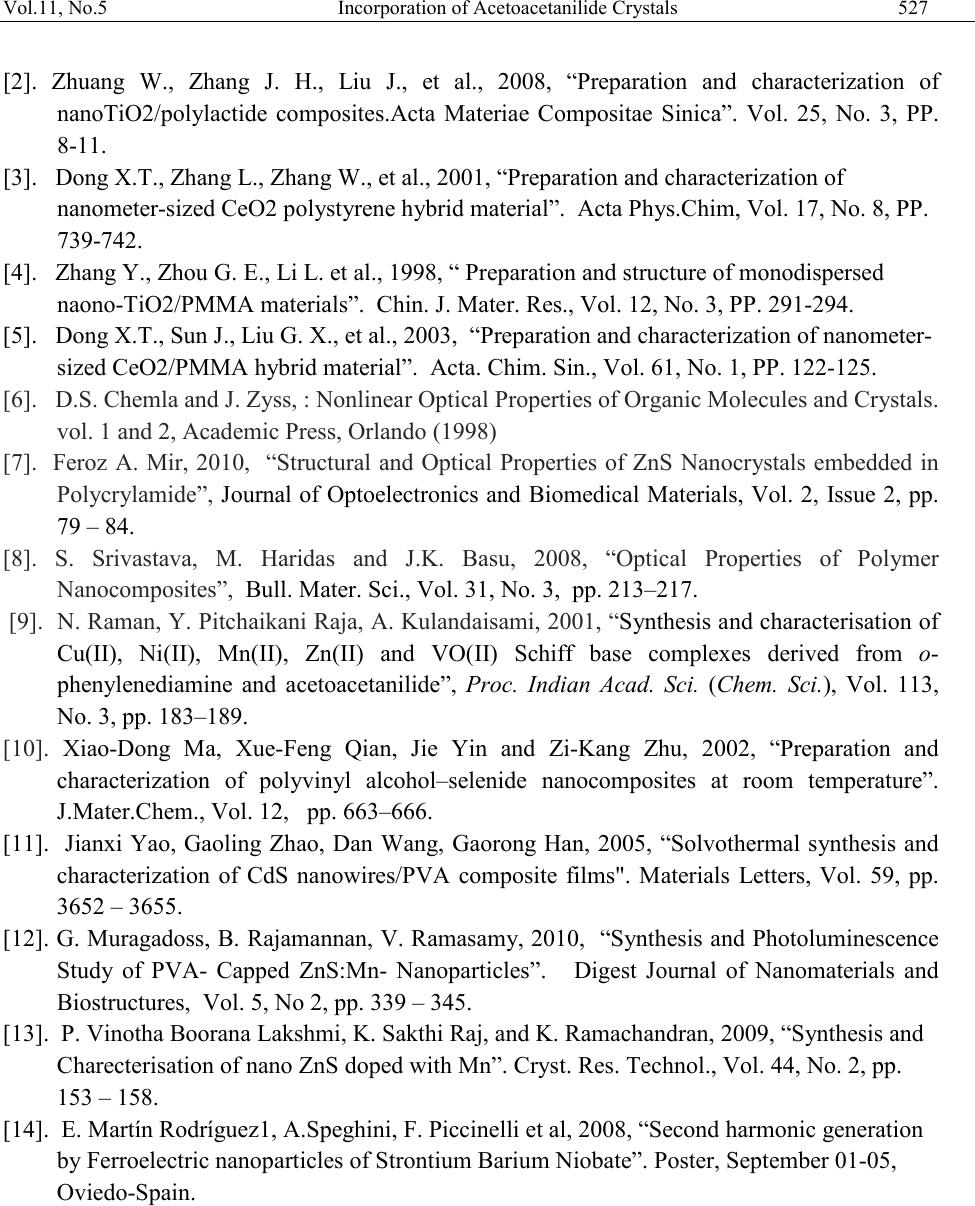
Vol.11, No.5 Incorporation of Acetoacetanilide Crystals 527
[2]. Zhuang W., Zhang J. H., Liu J., et al., 2008, “Preparation and characterization of
nanoTiO2/polylactide composites.Acta Materiae Compositae Sinica”. Vol. 25, No. 3, PP.
8-11.
[3]. Dong X.T., Zhang L., Zhang W., et al., 2001, “Preparation and characterization of
nanometer-sized CeO2 polystyrene hybrid material”. Acta Phys.Chim, Vol. 17, No. 8, PP.
739-742.
[4]. Zhang Y., Zhou G. E., Li L. et al., 1998, “ Preparation and structure of monodispersed
naono-TiO2/PMMA materials”. Chin. J. Mater. Res., Vol. 12, No. 3, PP. 291-294.
[5]. Dong X.T., Sun J., Liu G. X., et al., 2003, “Preparation and characterization of nanometer-
sized CeO2/PMMA hybrid material”. Acta. Chim. Sin., Vol. 61, No. 1, PP. 122-125.
[6]. D.S. Chemla and J. Zyss, : Nonlinear Optical Properties of Organic Molecules and Crystals.
vol. 1 and 2, Academic Press, Orlando (1998)
[7]. Feroz A. Mir, 2010, “Structural and Optical Properties of ZnS Nanocrystals embedded in
Polycrylamide”, Journal of Optoelectronics and Biomedical Materials, Vol. 2, Issue 2, pp.
79 – 84.
[8]. S. Srivastava, M. Haridas and J.K. Basu, 2008, “Optical Properties of Polymer
Nanocomposites”, Bull. Mater. Sci., Vol. 31, No. 3, pp. 213–217.
[9]. N. Raman, Y. Pitchaikani Raja, A. Kuland aisami, 2001, “Synthesis and characterisation of
Cu(II), Ni(II), Mn(II), Zn(II) and VO(II) Schiff base complexes derived from o-
phenylenediamine and acetoacetanilide”, Proc. Indian Acad. Sci. (Chem. Sci.), Vol. 113,
No. 3, pp. 183–189.
[10]. Xiao-Dong Ma, Xue-Feng Qian, Jie Yin and Zi-Kang Zhu, 2002, “Preparation and
characterization of polyvinyl alcohol–selenide nanocomposites at room temperature”.
J.Mater.Chem., Vol. 12, pp. 663–666.
[11]. Jianxi Yao, Gaoling Zhao, Dan Wang, Gaorong Han, 2005, “Solvothermal synthesis and
characterization of CdS nanowires/PVA composite films". Materials Letters, Vol. 59, pp.
3652 – 3655.
[12]. G. Muragadoss, B. Rajamannan, V. Ramasamy, 2010, “Synthesis and Photoluminescence
Study of PVA- Capped ZnS:Mn- Nanoparticles”. Digest Journal of Nanomaterials and
Biostructures, Vol. 5, No 2, pp. 339 – 345.
[13]. P. Vinotha Boorana Lakshmi, K. Sakthi Raj, and K. Ramachandran, 2009, “Synthesis and
Charecterisation of nano ZnS doped with Mn”. Cryst. Res. Technol., Vol. 44, No. 2, pp.
153 – 158.
[14]. E. Martín Rodríguez1, A.Speghini, F. Piccinelli et al, 2008, “Second harmonic generation
by Ferroelectric nanoparticles of Strontium Barium Niobate”. Poster, September 01-05,
Oviedo-Spain.